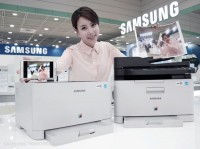 Electronics manufacturer will focus on printing industry to increase revenue to $400 billion by 2020.
Electronics manufacturer will focus on printing industry to increase revenue to $400 billion by 2020.
Yahoo! Finance reports that Samsung Electronics is planning to move towards the printing industry, despite it traditionally focusing on the manufacture of smartphones and televisions, as it looks to achieve annual revenue of $400 billion (€310.8 billion) by 2020 – more than double its 2012 revenue of $187 billion (€145.3 billion).
The OEM recently announced record quarterly profit of $8.3 billion (€6.5 billion), an increase of 47 percent from the previous year; and with its new target set, is looking to expand into previously untapped areas, including printing.
While the article notes the growing perception that the printing business is “dying” as the increasing use of mobile devices replaces the need for printing, Hyusang Ha, Vice President of product strategy for printing solutions at Samsung, said: “We feel the world of printing is changing,” with the OEM looking to penetrate the enterprise printing market, which unlike the consumer market is seeing growth of seven percent per year and is a bigger market.
In the consumer segment, Samsung has already claimed up to a quarter of the market share and reportedly has around five percent of the total global market; but Ha notes that this segment accounts for just over a tenth of the total $200 billion (€155.4 billion) market and is beginning to flatten out. For this reason, Ha says that Samsung will focus more on the enterprise segment, which involves the provision of “ongoing support, cloud hosting, set-up and maintenance, as well as continual supplies” and so will provide Samsung with regular revenue.
A way that Samsung is breaking into the segment is by building near-field communications (NFC) technology into its printers, allowing for a “tap to print” function using a phone or tablet device. Samsung predicts that this technology will soon be commonplace, and hopes that it will “counter the trend toward paperless-ness” as people will find it easier to print from their mobile devices.
